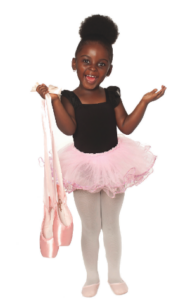
Tutu For You
As a toddler, my daughter Grace was shy and could usually be found in my arms or clinging to my leg. From the beginning, I had been determined to expose her to a variety of extracurricular activities, especially the arts—all in an effort to ensure that she has the tools necessary to build whatever future she could dream for herself. All I wanted was for her to find something she loved, something that would help develop her personality and build her confidence, for her to be somewhere where her hard work would yield personal satisfaction and she could meet new friends and excel. Too much to ask for?
Dance was the answer for my child. She emulates her name at five years old and has truly come out of her shell after just one year of classes, according to her instructor. Even when she isn’t at dance class, she constantly dances around the house like it’s her job. Starting early with soccer, however, was a different story. From my experience, it’s all about reading cues your child is sending and building on their individual interests. Just because an early start turns out well with one activity, it doesn’t mean your child is ready for all of them.
Kris Cangelosi, owner of the Cangelosi Dance Project School and Company, is an advocate for starting dance lessons early, teaching children as young as two. She explains, “Young children entering dance classes should already have shown some love for music and movement around the home.” Cangelosi looks for signals, “When young children are moving and smiling at the same time; this is your first indication that dance might be a place to start their first activity.”
Jennifer White, owner and teacher at Dance Center and School of Performing Arts, adds that, “A child can benefit from one hour of structured learning, especially if she has not entered school.” And as for the shy factor, White has witnessed the blossoming of many young dance students. “Simple things like dancing one at a time across the floor and being separated from mommy and daddy for a little while will boost confidence.”
Kinesthetic or tactile learning, meaning learning by doing, is the basis of dance. The benefits include flexibility, enhanced motor skills, following directions and creativity. With childhood obesity constantly increasing, establishing a trend of physical activity at a young age is essential. Cangelosi notes further advantages: “Young dancers begin to understand group work, following in a line, moving from one side of the dance room to the other, speaking when it is time and putting shoes in their bag for responsibility.” White adds another positive, “In the future, dancing can improve learning and school performance, specifically in math.”
When you recognize that your child is advanced in her physical development and gives signals that she is ready, even if she is just out of diapers, contact your local studio to see if there is a place for her and invest in a tutu.
Cangelosi remarks, “The creativity is what makes them move, sing and connect story with music and movement.” White encourages parents, “Dance will give your child opportunity to engage in improvisation and imaginative play while using her body. She will discover music and rhythm and how different sounds move the body in different ways.”
Dance may not be for every child but if your child walks around the house on her tip-toes, twirls endlessly, matches every beat on the radio or leaps gracefully in excitement, it’s safe to say dance lessons are worth a try. Local dance professionals say that confidence, discipline and a love for the arts are in the cards.





